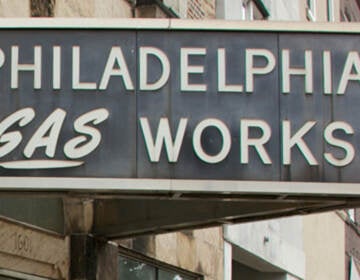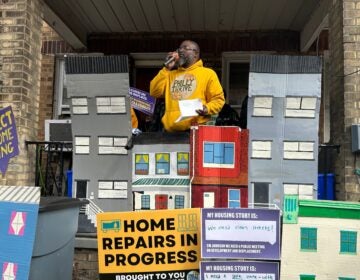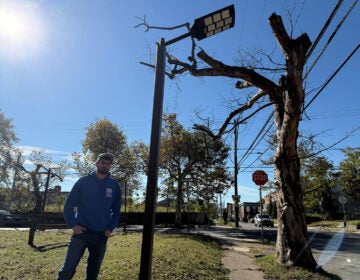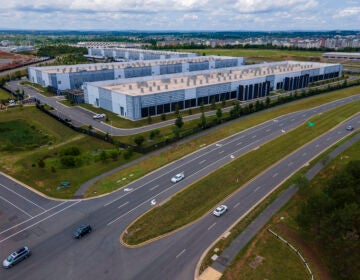EPA sets stricter air emission rules for 3 Philly-area polluters and dozens of others nationwide
The new restrictions will apply to over 200 facilities across the country. The EPA says they’ll cut cancer risk.
Listen 1:21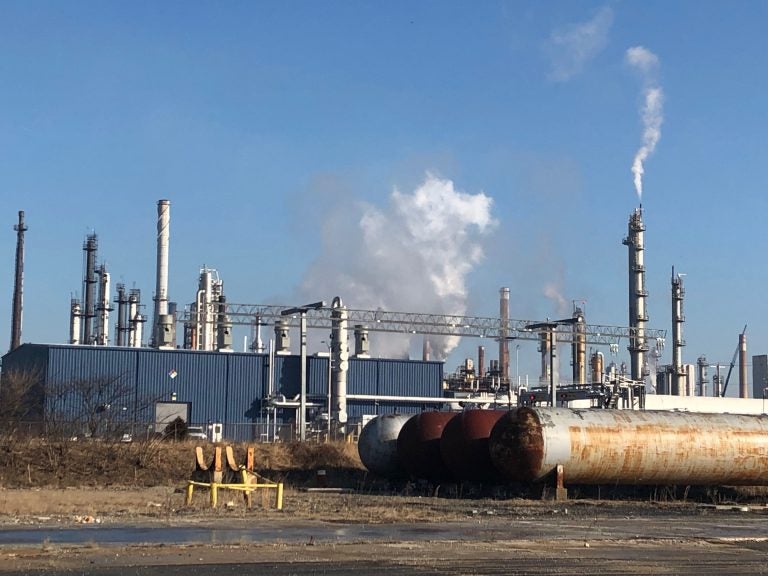
The Delaware City Refinery in Delaware City, New Castle County. (Cris Barrish/WHYY)
This story is part of the WHYY News Climate Desk, bringing you news and solutions for our changing region.
From the Poconos to the Jersey Shore to the mouth of the Delaware Bay, what do you want to know about climate change? What would you like us to cover? Get in touch.
A petroleum refinery and two chemical plants in the Philadelphia region will need to comply with tougher rules around hazardous air pollution.
The EPA finalized new rules last week that target plants that make certain types of chemicals, polymers and resins. The result will be less cancer risk in nearby communities, the agency says.
“These finalized rules will cut down on the whole series of toxic chemicals that are well known to cause disease, in some cases… cancer,” said Arthur Frank, a professor of environmental and occupational health at Drexel University.
The rules announced Tuesday regulate polluting processes and equipment such as flares, vents and heat exchange systems; remove exemptions from emissions control requirements during plant start-ups and shutdowns; and require more air monitoring at some plants. The EPA estimates they’ll prevent the release of over 6,000 tons of toxic air pollutants each year, as well as over 23,000 tons of pollution that contributes to smog.
More than 200 facilities nationwide, including the three in the Philadelphia region, will likely need to comply.
Advocates and experts view the rules as a win for environmental justice. People living near the facilities covered by the rules are disproportionately low-income or people of color, the EPA found. Most of the facilities that will fall under the new rules are in Louisiana or Texas.
“African American, minority communities are impacted disproportionately from this kind of pollution,” said Kabindra Shakya, a professor at Villanova University who studies air and soil pollution. “The risk for them hopefully will be reduced by this new rule.”
Big cuts to cancer risk, plus more air monitoring
The stricter rules will mean reductions in emissions of over 100 different hazardous air pollutants. But they focus on two particularly dangerous chemicals: ethylene oxide, which is used in manufacturing commercial products and to sterilize equipment, and chloroprene, which is used to make synthetic rubber. Both are linked to cancer.
The rules will reduce emissions of these two chemicals from the processes and equipment they cover by close to 80%.
In communities located near the facilities that use these two chemicals, the EPA estimates the rule will reduce the number of people who experience elevated cancer risk from toxic air pollution by 96%.
The rule also requires some facilities to monitor for these chemicals at the fence line, or the facility’s perimeter. If levels top certain thresholds, the companies will need to find the source of the emissions and make repairs.
“It’s forcing them to do something,” Shakya said.
Additional chemicals, including benzene, 1,3-butadiene, vinyl chloride and ethylene dichloride, will also have to be monitored at some facilities.
The first three are known human carcinogens, and the EPA considers the latter a probable human carcinogen.
The fence line air monitoring results will be published online four times a year, the EPA said.
“By having the fence line monitoring, what you allow is greater transparency, a greater understanding for the public and the EPA,” said Marilyn Howarth, an adjunct professor of pharmacology at the University of Pennsylvania and director of the Community Outreach and Engagement Core at the school’s Center of Excellence in Environmental Toxicology.
Fence line monitoring is important because it can help catch spikes in emissions and paint a picture of nearby communities’ exposure, Howarth said.
“It’s right at the fence, the edge of the property — in some places pretty close to where people are living,” she said. “Measuring it at that place is most predictive of what people may experience.”
Several facilities in the Philly region will be affected
Three active facilities in Pennsylvania, Delaware and New Jersey will be subject to the rules, according to a list released by the EPA.
These are the AdvanSix chemical plant in Philadelphia’s Bridesburg neighborhood, the Delaware City Refinery and a chemical manufacturer known as the Delaware River Plant in Bridgeport, N.J.
None of these facilities emit ethylene oxide or chloroprene — which present the highest health risks covered by the rules, according to the EPA. The Philly-area plants present lower health risks than many of the other facilities that come under the new rules, but the three do emit toxic air pollutants.
The AdvanSix plant in Philly is one of the largest producers in North America of phenol, which is ultimately used in the production of films, plastics and carpets, according to the company. The plant makes other chemicals, like acetone and alpha-methylstyrene, that are used in plastics, solvents and resins.
The EPA estimated the AdvanSix plant emitted more than 142,000 pounds of hazardous air pollutants in 2020.
The Delaware River Plant in Bridgeport, N.J., is owned by Valtris Specialty Chemicals, a company with locations all over the world that produces chemicals used in products such as plastics, PVC, pharmaceuticals and agrochemicals. The EPA estimated the Bridgeport plant emitted more than 32,000 pounds of hazardous air pollutants in 2020.
The Delaware City Refinery, located along the Delaware River in New Castle, Del., and owned by parent company PBF Energy, is one of the few operating crude oil refineries left on the East Coast (most U.S. petroleum refineries are located in Texas, Louisiana and California). It can process up to 180,000 barrels of crude oil per day and distribute its refined product by pipeline, truck, train or boat. The EPA estimated the refinery emitted over 200,000 pounds of hazardous air pollutants in 2020.
The refinery already monitors for cancer-causing benzene at its fence line under requirements from the EPA, and annual average concentrations picked up by its monitors have stayed beneath the EPA’s action level for the chemical for the last five years.
The EPA expects the Delaware City Refinery will also need to start monitoring for 1,3-butadiene at its fence line to comply with the new rules, a spokesperson said. The agency does not expect the other two Philly-area plants to start fence line monitoring under the new rules.
In addition to these three facilities, the EPA lists Montgomery Chemicals in Conshohocken, Pa., as subject to the rules. But the facility shut down in 2019 and no longer has a permit to operate, according to the Pennsylvania DEP. The facility settled a Clean Air Act case with the EPA in 2013, agreeing to pay $36,000 for violations related to emissions and monitoring of a hazardous air pollutant known as methanol, which the facility produced when manufacturing a bleaching agent for the paper industry.
A spokesperson for AdvanSix said the company is “actively assessing the final rule” to evaluate impacts on its Philadelphia plant.
Reached by phone, Valtris’ Chief Operating Officer Ron Masterson said the company is committed to operating in compliance with all local and federal regulations.
PBF did not respond to questions about the new rules by deadline.
The American Chemistry Council, an industry trade group, released a statement last week saying some of the new restrictions could affect production of essential everyday products such as those used in agriculture, health care, semiconductors and electric vehicles. The group said that some chemical facilities have already reduced their emissions of hazardous air pollutants, and that EPA’s finalized rules are based on “inflated risks and speculative benefits.”
Will the new requirements stick?
Existing plants must comply with the rules by different deadlines, based on their equipment and what they emit.
Facilities that produce neoprene will need to start monitoring for chloroprene 90 days after the rule goes into effect. Other facilities will have two years after the effective date to begin monitoring for the other chemicals.
But these sorts of rules are often fought in court, Frank said. At least one chemical plant in Louisiana already plans to challenge it, arguing the rule would force the plant to close because it would not be able to comply with the standards fast enough.
Lawsuits may not be the only threat to the rules.
“A new administration could come in with a new EPA and reverse these rules,” Frank said.
A proposed roadmap by the conservative Heritage Foundation for Donald Trump should he win the presidential election this fall would reshape the EPA, E&E News reported. It proposes cutting new hires in “low-value programs” within the EPA, resetting science advisory boards and eliminating the agency’s enforcement office and Office of Environmental Justice and External Civil Rights, putting those functions into other offices.

Get daily updates from WHYY News!
WHYY is your source for fact-based, in-depth journalism and information. As a nonprofit organization, we rely on financial support from readers like you. Please give today.





